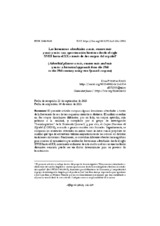Mostrar el registro sencillo del ítem
Las locuciones adverbiales a más, cuanto más y más y más: una aproximación histórica desde el siglo XVIII hasta el XX
| dc.contributor.author | Puertas Ribés, Elia | |
| dc.date.accessioned | 2022-09-22T12:21:31Z | |
| dc.date.available | 2022-09-22T12:21:31Z | |
| dc.date.issued | 2021 | |
| dc.identifier.issn | 2386-9658 | |
| dc.identifier.uri | http://hdl.handle.net/10396/23971 | |
| dc.description.abstract | El presente artículo compara algunas locuciones adverbiales a través de la frecuencia de uso de tres esquemas sintácticos distintos. El análisis se realiza en dos corpus diacrónicos diferentes: por un lado, un corpus epistolar, más próximo a la oralidad, y compilado por el grupo de investigación “Sociolingüística” de la Universitat Jaume I; y, por otro, el Corpus Diacrónico del Español(CORDE), asociado a géneros escritos más formales. Seguidamente, se comparan los resultados obtenidos en ambas bases de datos con el propósito de analizar qué tipo de estructuras utilizan mayoritariamente los autores en distintas tradiciones discursivas. Finalmente, se consultan diferentes fuentes lexicográficas para conocer el tratamiento que reciben las locuciones adverbiales desde el siglo XVIII hasta el XX, intentando esclarecer de este modo si el uso en una tradición discursiva concreta puede ser un factor determinante para su proceso de lematización. | es_ES |
| dc.description.abstract | This article compares some adverbial phrases through the frequency of use of three syntactic schemes. The analysis is carried out in two different linguistic corpora: on the one hand, an epistolary corpus, compiled by the “Sociolingüística” research group of the University of Jaume I; on the other hand, the Diachronic Corpus of Spanish (CORDE). Then, the results obtained are compared with the purpose of analyzing what type of structures the authors use in social interaction. Finally, different lexicographical sources are consulted to know the treatment received by adverbial phrases from the eighteenth century to the twentieth century, trying to clarify whether the use in a specific discursive tradition can be a determining factor for the process of lemmatization | es_ES |
| dc.format.mimetype | application/pdf | es_ES |
| dc.language.iso | spa | es_ES |
| dc.publisher | UCOPress | es_ES |
| dc.rights | https://creativecommons.org/licenses/by/3.0/ | es_ES |
| dc.source | Alfinge 33, 112-129 (2021) | es_ES |
| dc.subject | Fraseología diacrónica | es_ES |
| dc.subject | Tradiciones discursivas | es_ES |
| dc.subject | Locución adverbial | es_ES |
| dc.subject | Lingüística de corpus | es_ES |
| dc.subject | Diachronic phraseology | es_ES |
| dc.subject | Discursive traditions | es_ES |
| dc.subject | Adverbial phrases | es_ES |
| dc.subject | Corpora | es_ES |
| dc.title | Las locuciones adverbiales a más, cuanto más y más y más: una aproximación histórica desde el siglo XVIII hasta el XX | es_ES |
| dc.title.alternative | Adverbial phrases a más, cuanto más and más y más: a historical approach from the 18th to the 20th century using two Spanish corpora | es_ES |
| dc.type | info:eu-repo/semantics/article | es_ES |
| dc.relation.publisherversion | https://www.uco.es/ucopress/ojs/index.php/alfinge/index | es_ES |
| dc.rights.accessRights | info:eu-repo/semantics/openAccess | es_ES |

